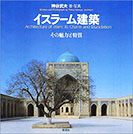The book was to be published 7 years ago (2007), but it has not been published yet. In Japan there is an enormous Construction Mafia that has long been persecuting me because of my papers criticizing their evil power dominating the field of architecture and construction in Japan. This affair has been obstructing and interrupting my work through tapping phones, intercepting and reading my e-mails, and trespassing in my house and office, and have ordered publishers not to publish my books. The publisher, Shoukoku-sha, refused to publish this book at the last stage of editing on false pretexts, and did not fulfill the contract which was to publish within half a year of receiving the manuscript.
The Mafia can manipulate even politicians and journalists. It is not only me being persecuted but also many architects who wanted to change the situation. This revolting state has been continuing for more than half a century, and a professional state of architects has not been established in Japan yet. Such a disgusting condition is only seen in Japan not in other developed countries: actuary a terrible society of architecture and construction.
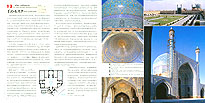 Page Sample
Page Sample
From FOREWORD
ISLAMIC CULTURE IS BEST REPRESENTED BY ARCHITECTURE
It seemed the world was moving toward a stable peace after the end of the Cold War, but no sooner did the 21st century arrive than the outline of another confrontation grew distinct. When the September 11, 2001 attacks occurred in New York and Washington, the United States emerged with a hostile policy against Islam, generating a critically tense situation in the world.
Although there has not been a day without a report concerning Islam in the papers and on TV since then, media attention has been prone to lean toward reports on political terrorism incidents by Muslim extremists. Therefore, such media play a role in planting the prejudice in people’s minds that Muslims are universally violent and uncivilized.
However, most Muslims, occupying one fifth of the world’s population, are people longing for peace just like most Japanese, as shown by their regular greeting: ‘Al-salam alaykum’ means ‘May peace be upon you.’ In order to prompt the world’s people to coexist in peace, it is first necessary for different cultures to understand and esteem each other.
In the case of Islamic culture, the general prohibition on idle-worship and similar acts has not let the arts of painting and sculpture (depicting living things) develop sufficiently. The same is true for drama and dancing. Therefore, the fields where Muslims’ desire for artistic expression can be displayed have mainly been architecture, gardening, and calligraphy. As gardens were integrated with buildings and calligraphy was used for the ornamentation of buildings, one must understand architecture above all else in order to become acquainted with Islamic culture.
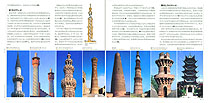 Page Sample
Page Sample
However, in Japan, publication on Islamic architecture so far has been quite insufficient compared to that on religious commentaries or political analyses of the Islamic world. The aim of this book is to supply a comprehensive compendium of Islamic architecture that is understandable not only for specialists but also for general readers.
The special feature of this book is the integration of the descriptions with a wealth of photographs taken by the author. When reading a book on architecture, it is a great frustration when one cannot grasp what is described due to the lack of photographs for each point. Because architecture is a visual art, one picture may be able to inform precisely and eloquently about a building or its details, which even a hundred lines of literary description cannot necessarily do.
In this book, I made it a rule to add a corroborating picture to every statement, clarifying the logical context. Though this book does not cover the history of architecture, such a handy book that describes plainly and visually the whole scope of Islamic architecture and elucidates its characteristics comprehensively is quite rare even in Europe, as far as I know.
COMPOSITION OF THIS BOOK
The first chapter displays the 21 masterpieces of Islamic architecture by means of color photos, plans, and explications like one would find in an architectural magazine. Although it was not easy to choose only twenty-one pieces from the numerous works of Islamic architecture in the extensive area from Spain in the west to China in the east, and in a time span of 1200 years from the 7th to the 19th century, I tried to balance my choices geographically and to show as wide a variety of Islamic facilities as possible. Viewing these works, readers should be able to grasp approximately what shapes and compositions of space Islamic architecture generally takes.
In the second chapter, Islamic worship space (i.e. Mosque) is expounded in detail; what elements a mosque is comprised of, what meaning and role each element has, and what differences they generated historically and geographically.
The third chapter examines Islamic architecture from the physical aspects. It was mainly developed in subtropical areas with deserts and little precipitation, differing from temperate regions with abundant rainfall and verdure such as Japan and Europe. Then what sorts of materials have Islamic buildings been constructed of, what kinds of structural systems were adopted for it, and what kind of ornamentation was invented for it?
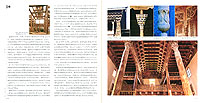 Page Sample
Page Sample
The principles and characteristics of mosque architecture investigated in the previous two chapters are actually applied not only to religious buildings but also to Islamic architecture in general. As there are almost no disparities between religious and secular edifices, the notion of ‘Islamic architecture’ includes various kinds of secular buildings, rather than just mosques. Then, what sorts of functional varieties are there in Islamic architecture? The forth chapter deals with this, tracing from dwellings to urban planning.
The fifth and final chapter summarizes what traits Islamic architecture has and what its ultimate purpose is, leading to the conclusion. In addition, this chapter includes how Islamic architecture concerned itself with the traditions of each region into which it spread, and finally has an overview of relations between contemporary architecture and Islam.
I believe readers will easily understand the traits of Islamic culture through the basic principles and various developments of Islamic architecture depicted in the above-mentioned chapters.
It is not for the ‘Clash of Civilizations‘ but for the ‘Coexistence of Civilizations’ in order to let the world’s people continue to live together, that we should learn the architectural cultures of India and Islam and find deep differences from those of Europe and Japan, from which we expect world architecture to become all the more rich and fruitful as a whole.
From AFTERWORD
 Map of the Islamic World
Map of the Islamic World
My relationship with Islamic architecture has continued for close to thirty years. The first encounter with it was in India. In the first place, I had been feeling antipathy to the situation in Japan, in which architectural society since the Meiji Restoration had been looking only toward Europe and America and ignoring the architecture of Asia, to which Japan belongs. That is why I did not choose Europe but India as the destination for a grand tour for three months to see foreign architecture on the occasion of my becoming independent as an architect.
There in India, there was a completely different world of architecture from the one that I had studied since my student days. The existence of another architectural culture that smashed my dualism of ‘Europe versus Japan’ excited me.
However, I was embarrassed when finding one more kind of architecture, Islamic architecture, as it was quite difficult to grasp its nature in comparison with indigenous Indian religious architecture (such as Buddhist, Hindu, and Jain architecture), which was easier to understand as Sculptural Architecture.
Islamic architecture is far more heterogeneous from my own territory of Japanese architecture because its formation seemed as if to be composed only of consistent geometric divisions.
Since then, I have traveled across Egypt, Turkey, Iran, and so on to compare each with Indian civilization, and at every place I encountered Islamic edifices. Since the style of each area is considerably different from the others, I could not get a handle on Islamic architecture’s fundamental principles and mutual relationships. Moreover, its sphere of distribution is extremely vast, from Spain to Indonesia, and it is disseminated particularly throughout the ‘third world’--in those days’ parlance.
I felt that unless I studied Islamic architecture sufficiently, I would not be able to understand world architecture as a whole. Thereupon I looked for books to read, but surprisingly, I found almost no books in Japan on the overview or history of Islamic architecture.
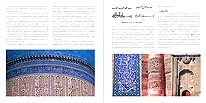 Page Sample
Page Sample
While I was inconvenienced by this situation, one day I found a new book on the history of Islamic architecture published in Switzerland at Maruzen, a famous foreign bookstore in Tokyo. Though it was written in French, I was just learning that language in order to study Romanesque architecture. Supposing that reading that book would be useful for studying both French language and Islamic architecture, I bought it straightaway and began to read.
It was such an interesting and instructive book that I reread it several times, and eventually I translated it into Japanese to publish for the architectural society in Japan. The book was Henri Stierlin’s “Architecture de l’Islam.” That Japanese edition was the first serious book on Islamic architecture in Japan, and yet people did not have much interest in Islam at the time, so it became an expensive book due to the small number of copies in the first printing.
In order to make the translation accurate, I visited not a few Islamic monuments in the world to affirm the descriptions in the book and take photographs of them, the process of which led me to fully understand the principles and evolution of Islamic architecture.
Two years later, I translated and published another book: John Brooks’ “The History and Design of the Great Islamic Gardens.” However, I grappled with the subject of Indian architecture after that and became somewhat estranged from Islamic architecture (except that of India).
When my research reached the certain point that I could publish my own work on the subject, “The Guide to the Architecture of the Indian Subcontinent,” I resumed studying Islamic architecture, traveling to Islamic countries to this day. During this time, the general concerns related to Islam have changed drastically in Japan. To be more exact, the world’s attitude toward Islam has completely changed since 9/11; along with the increase in intellectual interest in Islam after the world oil crisis, a popular cognizance of Islam as more or less terrifying has been broadly disseminated.
It is indeed regrettable that, following the USA’s lead in looking upon Islam as an enemy, Japan finally dispatched troops to Iraq, losing not a little of the confidence based on non-military pacifism that Japan had theretofore built in Islamic countries.
Now, for the sake of introducing not disputes with or in Islamic countries but the culture of Islamic architecture as peaceful production, I executed a plan to publish a compendium of Islamic architecture, working with Shokoku-sha, who has not published one book on that subject, in spite of being one of the few publishers in Japan specializing in architecture.
I inserted about 500 pictures in this book, selecting from the twenty thousand slide photos that I have taken myself so far, and incorporated a considerable quantity of information. I hope that this book will greatly deepen the recognition of Islamic culture in Japan.
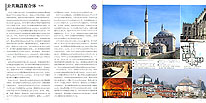 Page Sample
Page Sample
Even though taking the form of a compendium, this book is equally a discourse on Islamic architecture; a theory that Islamic architecture is ‘Membranous architecture’ or ‘Enclosing architecture’ when classifying the world architecture under the three categories of ‘Sculptural architecture,’ ‘Membranous architecture,’ and ‘Framework architecture.’ This is my cherished theory formed through longtime research at the foot of world architecture, not a borrowed theory from Western scholars.
All descriptions in this book are based on this view, which can be understood well enough through reading the book. However, there may be opponents, and I expect to hear dissenting opinions in order to develop the definition of Islamic architecture further.
This book examines Islamic architecture from various aspects, but is not a book on the history of architecture. Reading along with the before-mentioned book, “Architecture de l’Islam,” will bring a deeper comprehension of Islamic architecture. As for Islamic gardens, the also previously mentioned book, “The History and Design of the Great Islamic Gardens,” is useful, depicting the principles of Islamic gardening and its development mainly in Persia, Spain, and India.
10/ 12/ 2006
Takeo Kamiya
E-mail to the Iranian Ambassador to Japan
Dear Ambassador of Iran,
I’ve read this morning the article of your opinion “Wish for development of better relations between Iran and Japan” in the Asahi Shinbun.
although there is a close economical relation between Iran and Japan such as Japan owes much to Iran for Oil resources and Iran owes much to Japan for Industrial products, and most Iranians hold very friendly and familiar feeling to Japan, Japanese people necessarily have enough understanding or knowledge of Iran. You as Iranian ambassador must be surely aware of it.
When I was a university student of architecture, I could not approve of the Japanese tendency to learn solely European and American architecture and follow them, neglecting Asian architecture. So, since I became an independent architect I have been studying Indian and Islamic architecture, traveling widely in Asian countries. In Iran, I traveled for taking photographs of historical architectural works for 3 weeks in 1980, for 3 weeks in 2004, and for one month in 2007. The stock of color slides of Iranian architecture all over the country numbers in the 2,000 as semi-professional photos using a high-grade camera and camera-stand.
I am introducing in my website the Sheikh Lutfollah Mosque in Isfahan and the Desert Town of Bam in the pages of “Gallery of World Architecture,” and the Friday Mosque in Zavareh and Tarik-Khane Mosque in Damghan in the pages of “Sacred Architecture in the World.” In 1987 I published a book “Architectural Culture of Islam” translated from French by me, and in 1989 “Design of Paradise, Gardening Culture of Islam” translated from English by me.
In spite of such endeavor, the notion for the Islamic world by Japanese people in general has not advanced so much in these 30 years. Rather people have prejudices like “I dread Islamic countries” or “Muslims could be violent people.” The principle reason is considered that the reports of Islamic countries on the TV or Newspapers are always negative images such as Terrorism, War, Kidnapping, and Shooting up of oil prices, etc.
In recent years in Japan, the Korean drama “Winter Sonata” has gotten a great reputation. Most Japanese who had not embraced good feelings to Korea have changed through the fashion of this drama, increasing affinity and love with Korea. Cultural exchange between the two countries has made great progress. When one regards relations with foreign counties through political and economical points of view, there can be mostly confrontations of interests. But art and culture can take away such obstacles and have a power to reconcile and make people intimate each other.
The film works of Abbas Kiarostami and other directors performed such a role, but it can be said that the representatives of Islamic culture must be Architecture and Gardens after all. Recognizing the beauty and greatness of Islamic architecture, Japanese people could change their notion of Islam and will have familiar feeling on such Islamic countries as Iran, Turkey, Egypt, and others who keep enormous heritages of Islamic architecture and gardens.
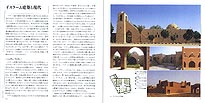 Page Sample
Page Sample
So, I wrote a book entitled “ARCHITECTURE OF ISLAM: Its Charm and Elucidation” two years ago, as the first serious and comprehensive book on Islamic architecture. It includes from the principles of Islam to the characteristics of Islamic architecture, putting a lot of color photographs to be comprehensible and attractive for the general public. As it was also written with expertise, I am even hoping it will be translated not only in English but also in Persian to be published in Iran (the English edition of my book “The Guide to the Architecture of the Indian Subcontinent” has been published in India).
However the publisher, Shoukoku-sha, at the last stage of editing refused to publish this book, ignoring even the publishing contract to have to publish within half a year after receiving the manuscript from the auther. It is quite unhappy not only for Japanese people but also for Islamic countries that the book, which is to bring image-up of Islam in Japan, is not published. Behind all this there is a dark and complicated background of Japanese architectural society, but leaving it outside, the organizations of Islam in Japan and Embassies of foreign countries would be disgusted by this topic of disturbance of the publication of my book. Then, I would like to ask Embassies of Islamic countries in Japan to make a protest to the publisher and demand to publish the book soon.
The details are written in my website ( http://www.ne.jp/asahi/arc/ind/ ), in the pages of “Information” or “Publications.” I enclose a copy of the introduction of the book “Architecture of Islam” printed out from that. I will appreciate if you appeal to the other Embassies of Islamic countries to do the same.
01/ 07/ 2008
Takeo Kamiya, architect
|
